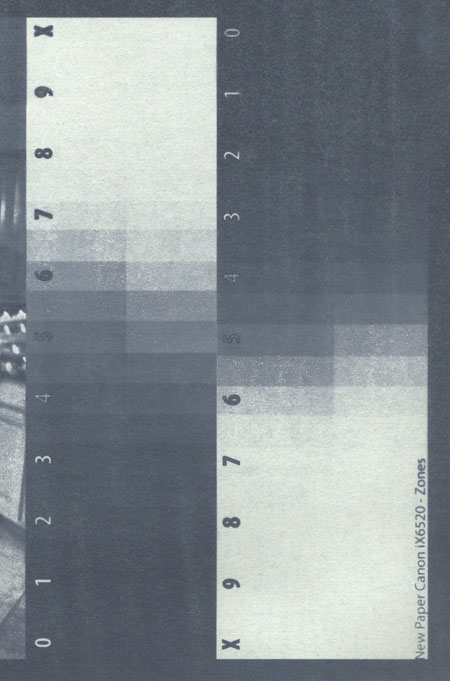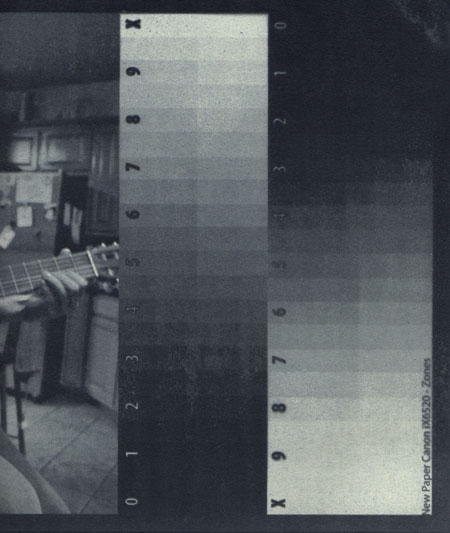Dividing the Scale
In a previous section on duotones, we saw how combining 2 layers gives a printer
separate control over highlights and shadows to create a longer scale. Perhaps
you would want more control than that, why stop at two layers? I have made
prints using 1, 2, 3, 4, or more layers at different exposures. The image to
the right was printed using 5 layers of paynes gray, one for the darkest shadows,
another for the shadows, the midtones, the highlights, and the brightest highlights.
As a printer it is up to you to decide how many layers you are willing to
print on a normal basis. Over the years I have settled on using 3 layers, a
layer for shadows, a layer for midtones, and a layer for highlights. More layers
caused greater frustration and fewer layers didn't produce the quality I hoped
for.
Exposure Times
Once you decide the number of layers to print, (in the following tutorials
I will be using 3 layers) choose which exposure times you would like to use.
In the past I have used many combinations of times ranging form 1 minute up
to 30 minutes! I cannot say which exposure times will work best for you. That
depends entirely on your printer's ink, your UV light source, your paper choice,
and a multitude of other variables. The purpose of calibrating an inkjet negative
is to neutralize all those variables and make your gum printing predictable.
To begin, find an exposure time that prints well with a single layer of
emulsion. You may consider printing a few tests starting around 5 minutes,
using the zones negative we created in the last section and a neutral color
pigment like gray. Look for an exposure time that prints the scale centered
near the mid-tones.
There are many variables that affect this time from the type of ink your printer uses, the paper you use, the light source you expose with, the exact manner you develop a print, and so forth. With my current setup, I find 4 minutes gives me a centered scale under my UV light unit. Under a sunlight exposure the time would be much shorter, probably around 2 minutes. (Don't worry about getting into the precision of seconds trying to use a specific time of say 3 minutes and 22 seconds. You will only drive yourself insane! All that matters is accuracy, not precision.)
A printed gum bichromate scale centers close to zone V with 4 minutes of exposure with my equipment.
This exposure time will be good for the middle of your exposure times. Divide it in half for a shadow exposure time and double it for your highlight exposure time. My exposure times are thus: 2 minutes, 4 minutes, and 8 minutes.
If you choose to print more than three layers, your times may continue extending
outward in squares. In other words, if I wanted to use 5 layers I might use
1, 2, 4, 8, and 16 minutes. Or perhaps 2, 4, 8, 16 minutes for four layers.
The First Test Scale
Now that exposure times are determined, make a print using 3 layers at three
different exposure times. In the end we will make a few of these prints. Each
layer takes approximately one day to complete because of all the drying time
involved with each layer. Expect the tests to put your own patience to the
test! It took me from December 23, 2011 to January 22, 2012 to complete the
test featured here, an entire month! If you budget your time better than I
(it was the holidays after all), you could complete the test within a week.

First, use your zones negative to make an exposure of your middle time. My time as stated above was 4 minutes. In reality you could just use the previous test print since you've already made an exposure at that time.
(Note that in my example I was testing 2 different scales at the same time. You can see each of the scales seem to split in two down the center. You can ignore this)

Once the first layer is printed and dried (often the next day, but hair dryers can help), apply a second coat of emulsion over the print. This layer will be exposed at double the time and needs to be more translucent so it is important to use less pigment when mixing the emulsion. I used 1/2 of the pigment I used on the first layer.
This printed scale now shows what a 4 minute layer and an 8 minute layer look like when over printed. I call it a "4-8" exposure.
Notice that the scale on the left and the scale on the right printed slightly differently. On the left the scale printed well into zone 9 1/2, but on the right it barely made it past Zone 8. This may be a consequence of my uv light box providing uneven exposure, or maybe unevenness when applying

Once that second layer is dry, go ahead and apply a third layer of gum bichromate emulsion. This layer will be printing the shadows and so I used the normal amount of pigment in my emulsion.
This exposure was only 2 minutes and you can see that the highlights remain (mostly) unchanged, while the shadows got darker.
Now, if you look closely you will see the layers are anything but smooth. I have found printing short exposure times over other layers tends to cause the emulsion to crack up a bit. I believe this is due to the previous layers becoming somewhat slimy when wet, and it becomes more difficult for the newly applied layer to adhere properly.
Ideally you should expose your layers from shortest exposure to longest exposure. However the tests we conduct will account for any crackling or roughness that may occur in these test prints.
The third layer of our print surely has achieved what we were after, a very
long scale! It extends from somewhere around zone 8 or 9 before becoming white
and all the way down to zone 2 before becoming solid black. However, as we
have already discussed, the print is way too dark. The subjective value of
middle gray seems to fall on zone 7 or so, not 5 where it should be. Next
we will measure this scale and make our first custom inkjet transparency scale.





